I needed to align two subplots but not at their zeros. And other solutions didn't quite work for me.
The main code of my program looks like this. The subplots are not aligned. Further I only change align_yaxis function and keep all other code the same.
import matplotlib.pyplot as plt
def align_yaxis(ax1, v1, ax2, v2):
return 0
x = range(10)
y1 = [3.2, 1.3, -0.3, 0.4, 2.3, -0.9, 0.2, 0.1, 1.3, -3.4]
y2, s = [], 100
for i in y1:
s *= 1 + i/100
y2.append(s)
fig = plt.figure()
ax1 = fig.add_subplot()
ax2 = ax1.twinx()
ax1.axhline(y=0, color='k', linestyle='-', linewidth=0.5)
ax1.bar(x, y1, color='tab:blue')
ax2.plot(x, y2, color='tab:red')
fig.tight_layout()
align_yaxis(ax1, 0, ax2, 100)
plt.show()
Picture of not aligned subplots
Using @HYRY's solution I get aligned subplots, but the second subplot is out of the figure. You can't see it.
def align_yaxis(ax1, v1, ax2, v2):
"""adjust ax2 ylimit so that v2 in ax2 is aligned to v1 in ax1"""
_, y1 = ax1.transData.transform((0, v1))
_, y2 = ax2.transData.transform((0, v2))
inv = ax2.transData.inverted()
_, dy = inv.transform((0, 0)) - inv.transform((0, y1-y2))
miny, maxy = ax2.get_ylim()
ax2.set_ylim(miny+dy, maxy+dy)
Picture without second subplot
Using @drevicko's solution I also get aligned plot. But now the first subplot is out of the picture and first Y axis is quite weird.
def align_yaxis(ax1, v1, ax2, v2):
"""adjust ax2 ylimit so that v2 in ax2 is aligned to v1 in ax1"""
_, y1 = ax1.transData.transform((0, v1))
_, y2 = ax2.transData.transform((0, v2))
adjust_yaxis(ax2,(y1-y2)/2,v2)
adjust_yaxis(ax1,(y2-y1)/2,v1)
def adjust_yaxis(ax,ydif,v):
"""shift axis ax by ydiff, maintaining point v at the same location"""
inv = ax.transData.inverted()
_, dy = inv.transform((0, 0)) - inv.transform((0, ydif))
miny, maxy = ax.get_ylim()
miny, maxy = miny - v, maxy - v
if -miny>maxy or (-miny==maxy and dy > 0):
nminy = miny
nmaxy = miny*(maxy+dy)/(miny+dy)
else:
nmaxy = maxy
nminy = maxy*(miny+dy)/(maxy+dy)
ax.set_ylim(nminy+v, nmaxy+v)
Picture without firstsubplot
So I've tuned @drevicko's solution a little and got what I wanted.
def align_yaxis(ax1, v1, ax2, v2):
"""adjust ax2 ylimit so that v2 in ax2 is aligned to v1 in ax1"""
_, y1 = ax1.transData.transform((0, v1))
_, y2 = ax2.transData.transform((0, v2))
adjust_yaxis(ax1,(y2 - y1)/2,v1)
adjust_yaxis(ax2,(y1 - y2)/2,v2)
def adjust_yaxis(ax,ydif,v):
"""shift axis ax by ydiff, maintaining point v at the same location"""
inv = ax.transData.inverted()
_, dy = inv.transform((0, 0)) - inv.transform((0, ydif))
miny, maxy = ax.get_ylim()
nminy = miny - v + dy - abs(dy)
nmaxy = maxy - v + dy + abs(dy)
ax.set_ylim(nminy+v, nmaxy+v)
Subplots as I've expected them to look



